Derby's Heritage Part 31 - To The Silk Mill
w/e 29 July 2012
All this week's pictures were taken
with a Kodak DX6490
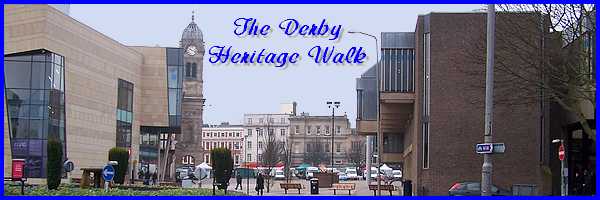
I looked up the word "heritage" and one
definition I found was "Something that is passed down from
preceding generation". The Derby Quad building therefore,
a centre for art and film with a cinema, gallery, cafe bar and
workshop can probably be classed as Derby's heritage of the future
but its design has no doubt split the present generation. I saw
it being constructed in recent years and often quipped that either
the draughtsman's set square must have slipped or the builder
had the plans folded when referring to them.
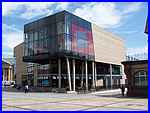 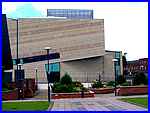 Whatever
your opinion it has to be admitted that it is a striking building
standing as it does in the Market Square next to the Royal Oak
House that is now home to the Derby's Register Office and which
dates from the 1880s. That is where we concluded Part 30 of the
Heritage Walk around the city and we resume this part in the
Sir Peter Hilton Memorial Garden at the rear of the Quad. Whatever
your opinion it has to be admitted that it is a striking building
standing as it does in the Market Square next to the Royal Oak
House that is now home to the Derby's Register Office and which
dates from the 1880s. That is where we concluded Part 30 of the
Heritage Walk around the city and we resume this part in the
Sir Peter Hilton Memorial Garden at the rear of the Quad.
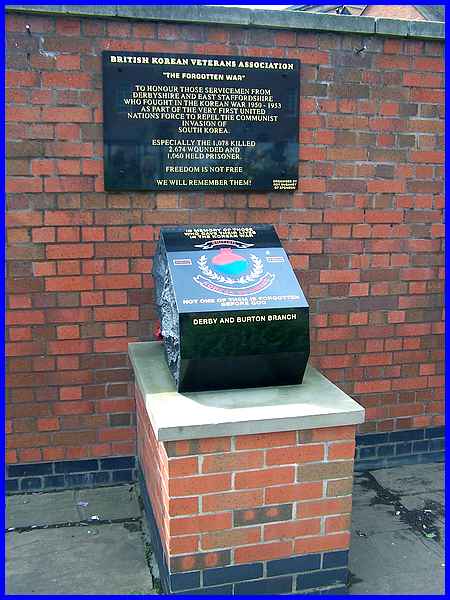
The stone memorial to the Derby British Korean Veterans in the
garden was constructed in July 2003 to celebrate the 50th anniversary
of the ceasefire and is inscribed "In memory of those who
gave their lives in the Korean war". It bears the dates
1950 and 1953 and the words "Not one of them is forgotten
before God".
|
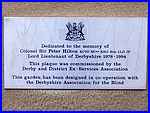 Another small plaque
(right) close to the memorial reads "Dedicated to the memory
of Colonel Sir Peter Hilton KCVO MC** KStJ Hon LLD JP Lord Lieutenant
of Derbyshire 1978-1994. This plaque was commissioned by the
Derby and District Ex-Services Association. This garden has been
designed in co-operation with the Derbyshire Association for
the Blind." Sir Peter served in the Royal Artillery in World
War II and was evacuated from Dunkirk, going on to see action
at Alamein, in Italy and the Normandy invasion of 1944, when
he was badly wounded. He went to Greece as an instructor in 1950
but was recalled due to the Korean War. Another small plaque
(right) close to the memorial reads "Dedicated to the memory
of Colonel Sir Peter Hilton KCVO MC** KStJ Hon LLD JP Lord Lieutenant
of Derbyshire 1978-1994. This plaque was commissioned by the
Derby and District Ex-Services Association. This garden has been
designed in co-operation with the Derbyshire Association for
the Blind." Sir Peter served in the Royal Artillery in World
War II and was evacuated from Dunkirk, going on to see action
at Alamein, in Italy and the Normandy invasion of 1944, when
he was badly wounded. He went to Greece as an instructor in 1950
but was recalled due to the Korean War.
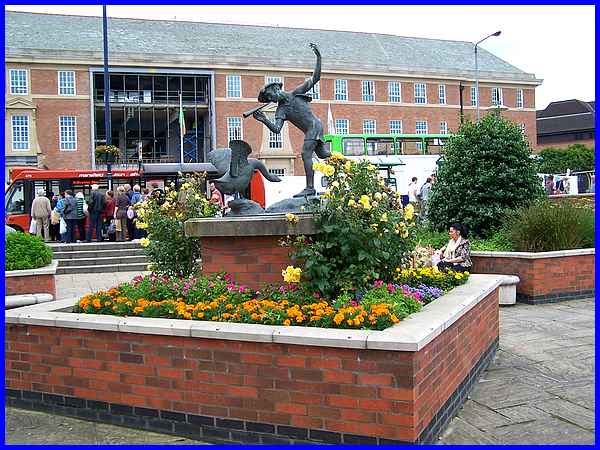
As the plaque shows Sir Peter was honoured several times and
he became Lord Lieutenant of Derbyshire in 1978, a post he held
until 1994. This small garden dedicated to his memory features
a statue of a "Boy and Goose" as the centrepiece among
the raised flower beds. The bronze statue of 1926 by Andrew Fisher
was originally known as the "Boy and Gander" and it
has stood in several locations including the Market Place and
the Riverside Gardens before eventually finding its present position
here in the Memorial Garden.
|
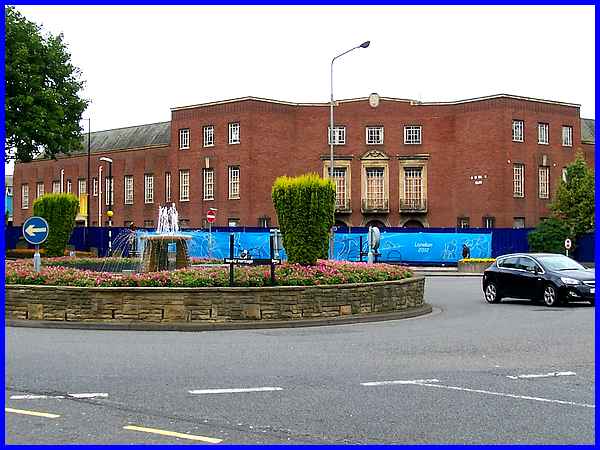
Very early on in this series we left the Market Place and headed
north along Irongate towards Derby Cathedral and we now head
off in the same direction but this time along Full Street. On
the corner of Full Street and Derwent Street are the former Magistrates'
Courts which are Listed Grade II buildings. They were completed
to a 1931 design by Borough Architect Charles Herbert Aslin in
1934, incorporated a Police Station and were part of the Central
Improvement Scheme to rebuild the entire riverside area. The
Courts and the Police Station have stood empty for a number of
years now pending redevelopment but with the current financial
climate and the listed status of the Courts, I fear the future
for the site is still uncertain.
|
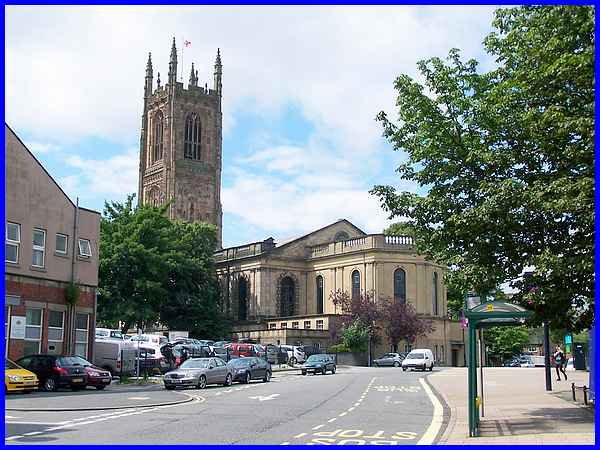
Whereas Irongate leads to the front entrance to the cathedral,
Full Street passes to the rear. The origin of the name Full Street
is the subject of some debate as it was once thought to be because
of the occupation of cloth fulling by the river's edge. Alternatively
it could also be from the Anglo Saxon "ful" meaning
"foul" but in contrast it was later a highly fashionable
address and was one of the first streets in Derby to be paved.
Whatever the truth of its origin, the street has gone by this
name for centuries and was shown as such on a map of 1599. Today
it is not unusual to see ornithologists gathered here training
their binoculars and telescopes on the tower of the cathedral
as they watch the peregrine falcons that nest there. Those with
internet access though can get a close up view of the birds via
a dedicated
webcam.
|
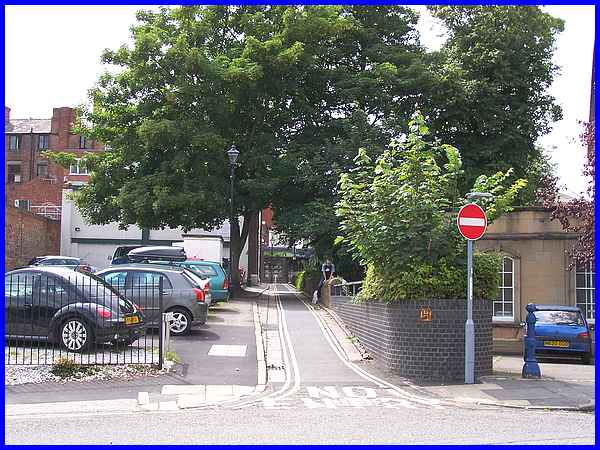
The narrow street at the side of the cathedral leading through
to Irongate is called Amen Alley reputedly because people at
prayer in the church could be heard saying their 'Amens' here.
There is an interesting photo on the Picture The Past site showing
a building where the cars are now parked that was standing derelict
on the corner of Full Street in 1882. Click here to view.
|
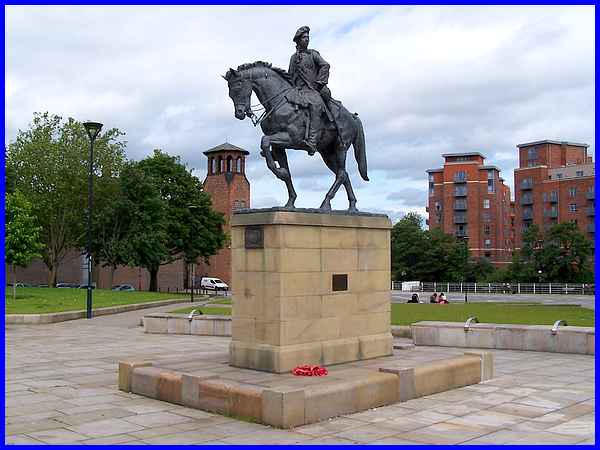
Directly across Full Street from the cathedral is an open space
now called Cathedral Park where a statue of Bonnie Prince Charlie
was unveiled in 1995. The statue is by Glossop born sculptor
Anthony Stones and commemorates the Prince's arrival in Derby
in 1745. In the story well known by historians, the Prince was
on his way to London to overthrow the King but realised on reaching
Derby that he had insufficient troops and decided to retreat.
Ultimately this led to the infamous Battle of Culloden on April
6th 1746 following which thousands of Scots had their homes burned
to the ground, their cattle slaughtered and were themselves deported
across the Atlantic.
|
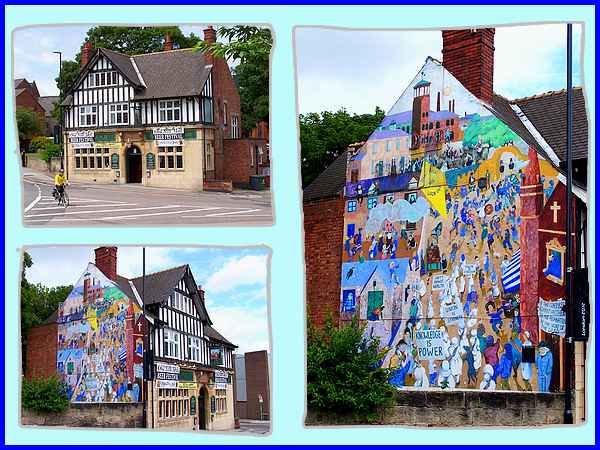
Although our route now is to the Silk Mill Museum across Cathedral
Park, it is well worthwhile continuing a little further along
Full Street to see the mural painted on the side of the Silk
Mill pub. Painted in the mid 1980s by the Derby Community Arts
Project, it depicts the Silk Trades Lock Out of 1883, a conflict
that lasted about eight months. This is significant in industrial
history as it was the first ever strike action for better wages
and working conditions.
|
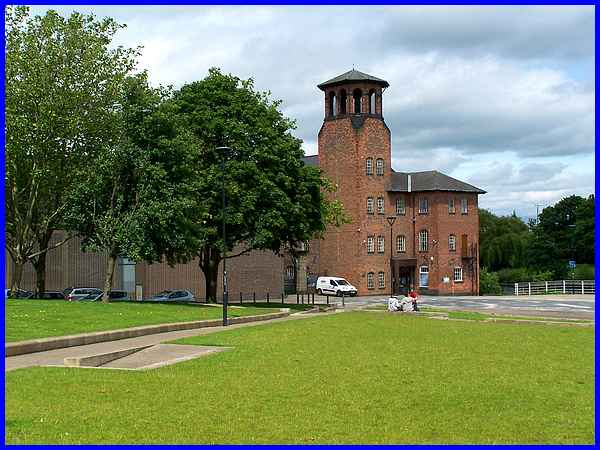
Our objective in this part of the walk is the Silk Mill Museum
which stands by the River Derwent just across Cathedral Park
from the Bonnie Prince Charlie statue. The park was created on
the site of the Derby Power Station which had been built by John
Ward in 1908 but was demolished in 1972.
The economic climate and cut backs resulted in the Silk Mill
Museum being "moth-balled" for two years by Derby City
Council on April 3rd 2011. Since then the museum, that marks
the southern end of the Derwent Valley Mills World Heritage Site,
has only been opened for specific ad-hoc events but it is there
that we will continue in the next part.
|

